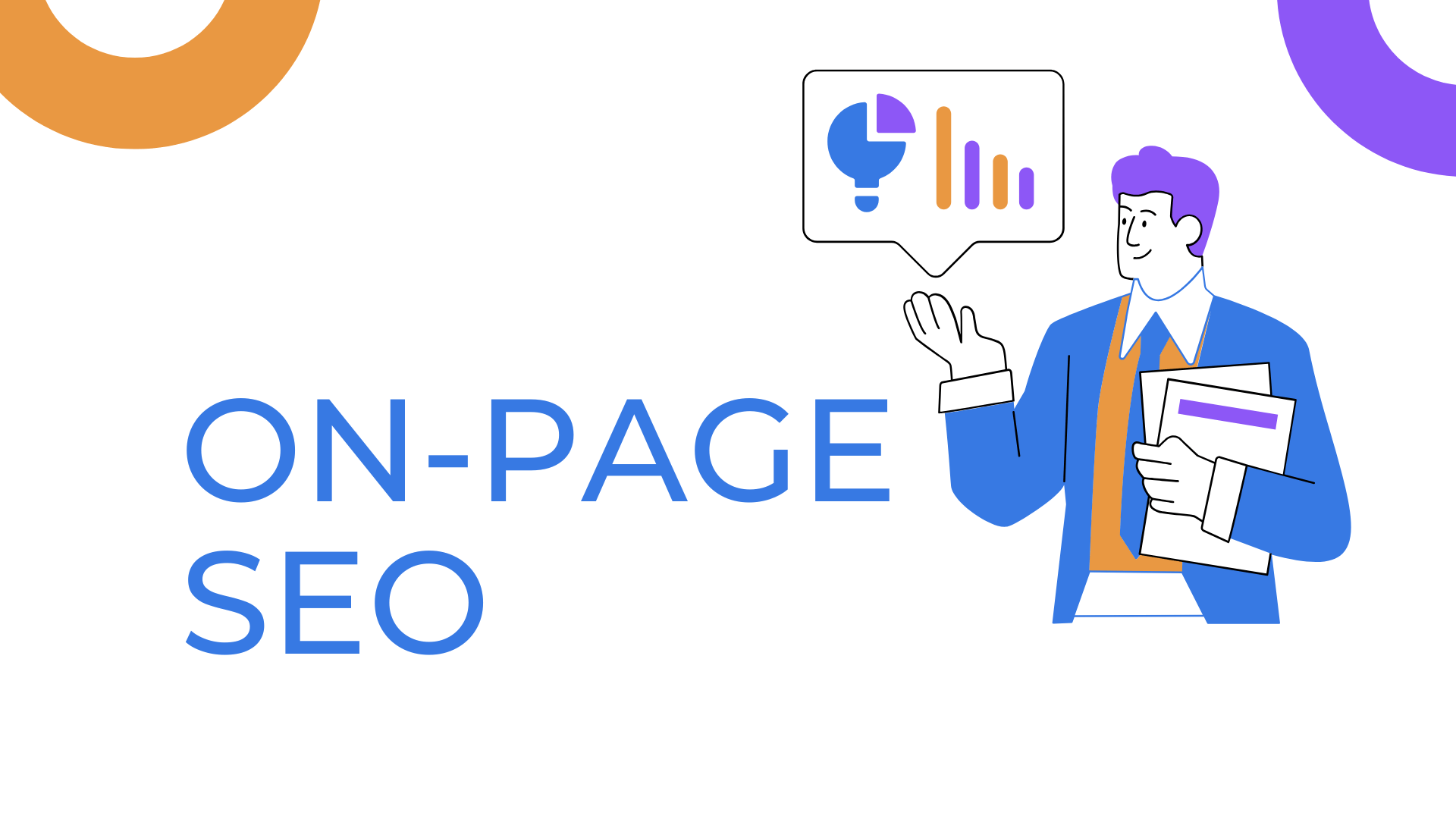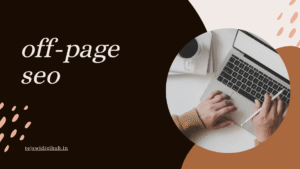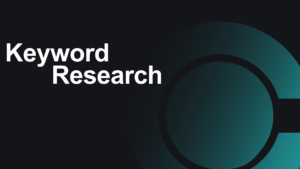Unlocking Superior Search Visibility: Your Expert Guide to On-Page SEO
In digital marketing, on-page SEO – optimizing elements within your website – is the silent engine of organic growth. It makes content clear, valuable, and accessible to both search engines and users. For higher SERP rankings and qualified traffic, mastering on-page in SEO isn’t just an advantage; it’s an absolute necessity. This guide explores key on-page SEO factors and techniques to boost your rankings and enhance user experience for lasting digital triumph.
Understanding the Core: What Exactly is On-Page SEO?
On-page SEO involves all direct optimization efforts on your website’s pages. It’s like setting up your digital storefront to be easily found, understood, and appealing to customers. Unlike off-page SEO (external signals), on-page SEO gives you direct control over how search engines perceive your content’s relevance and quality, ensuring every element signals value.
The Bedrock of Digital Discoverability
At its heart, on-page in SEO prioritizes clarity and relevance. Search engines strive to deliver the most accurate results. Optimizing on-page elements provides a clear map for crawlers, helping them swiftly grasp your page’s topic and its relation to search queries. Without strong on-page signals, even brilliant content can remain hidden.
Here’s why establishing this foundation is key:
Augmented Discoverability: A thoughtfully structured site is more likely to be found and indexed.
Unambiguous Signals for Search Engines: Optimized elements enable crawlers to precisely categorize your content.
Heightened Relevance for Users: Clear signals ensure your content appears for highly pertinent searches.
Why On-Page SEO is More Indispensable Than Ever Before
The digital landscape is increasingly competitive. The nuances of effective on-page SEO factors now differentiate success from obscurity. Modern algorithms decode user intent and content context, not just keywords. Thus, intelligent on-page optimization, prioritizing user experience and semantic relevance, is paramount. Heading towards 2025, E-E-A-T (Experience, Expertise, Authoritativeness, and Trustworthiness) further solidifies user-centric on-page elements as critical.
Here’s why on-page SEO’s importance is escalating:
Intensified Competition: Meticulous on-page precision offers a crucial advantage in crowded markets.
Advanced Algorithm Comprehension: Search engines now grasp context and relationships, not just isolated keywords.
User Intent Centrality: Direct optimization for user intent profoundly impacts content relevance and ranking.
E-E-A-T Imperative: High-caliber, trustworthy on-page content builds authority.
Elevating Your Content: Essential On-Page SEO Optimization Techniques
Having established the profound “why” behind on-page SEO, let’s now transition to the practical “how.” These are the concrete, actionable on-page SEO optimization techniques that form the bedrock of any truly successful and resilient SEO strategy.
Sculpting Your HTML: Best Practices for Header Tags
HTML header tags (H1, H2, H3, and so forth) transcend mere formatting; they are fundamental organizational tools that impart vital structure and hierarchy to your content. This structural clarity significantly improves digestibility for both human readers and the sophisticated algorithms of search engines.
H1 (Your Definitive Title): Crucially, every page must feature one, and precisely one, H1 tag. This serves as your main, overarching heading and should ideally incorporate your primary keyword (“on page seo” for this very article). Envision it as the title of a book; it instantly communicates the page’s core subject matter to both visitors and search crawlers.
H2 (Major Section Dividers): Employ H2 tags to segment your content into distinct major sections. These headings should logically flow from your H1 and present opportune moments to naturally weave in secondary keywords or nuanced variations of your primary term. For instance, “Understanding the Core: What is On-Page SEO?” functions as an H2 in this discussion.
H3 (Refining Subsections): H3 tags serve to further subdivide your H2 sections, introducing more granular detail and specificity. They are instrumental in organizing complex subjects into easily scannable, digestible chunks and are excellent for the natural integration of long tail keywords.
Upholding Hierarchy: Always rigorously maintain a logical hierarchical structure (H1 > H2 > H3). Avoid skipping levels, such as jumping directly from an H1 to an H3 without an intervening H2. This consistent structure not only enhances content readability but also signals to search engines the relative importance and relationships between different content segments.
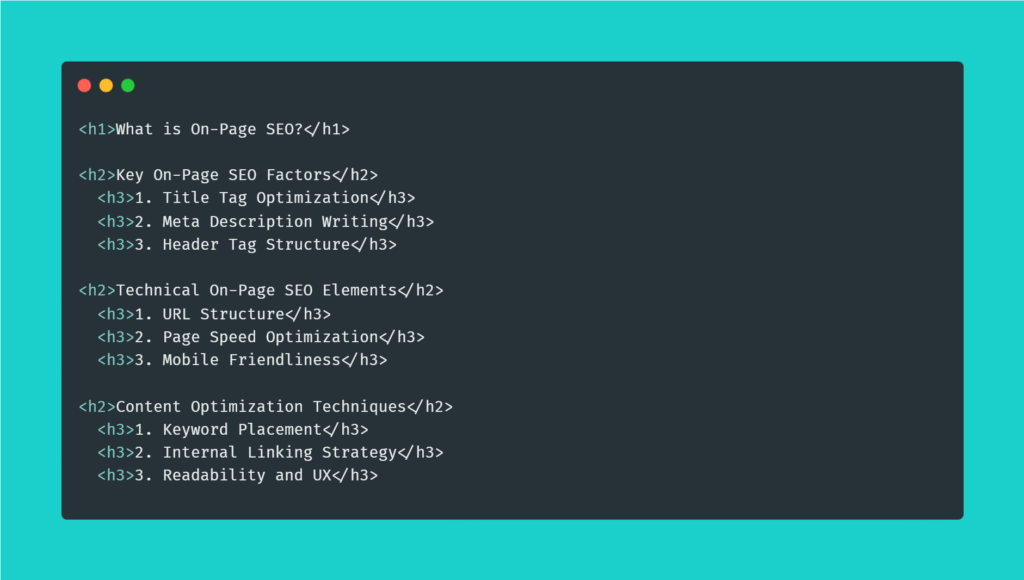
Visual Content That Ranks: Optimizing Image Alt Text
Visuals are indispensable for enhancing engagement, yet search engines inherently cannot “see” images in the way humans do. This is where alt text becomes vital. Image alt text optimization is the practice of providing a concise, descriptive alternative text attribute for every image.
Descriptive Accuracy: Your alt text must accurately and clearly describe the visual content within the image. This is not merely an SEO tactic but a critical component of web accessibility, enabling screen readers to effectively convey image information to users with visual impairments.
Natural Keyword Integration: Where genuinely relevant and seamlessly natural, subtly incorporate a target keyword. For example, an image depicting various “on-page SEO factors” might have alt text like: “Detailed infographic illustrating key on-page SEO factors.” Rigorously avoid keyword stuffing here; the primary goal is a helpful and accurate description.
Contextual Relevance: The alt text should always maintain strong relevance to the surrounding textual content on the page.
Beyond the Initial Click: Optimizing Meta Titles and Descriptions
The meta title and meta description function as your website’s virtual storefront display within the search engine results. While their direct impact on ranking might be debated, their profound influence on click-through rates (CTR) is undeniable, and CTR, in turn, acts as a powerful relevance signal to search engines. Therefore, meta title and description optimization is fundamentally about crafting compelling snippets that entice users to click.
Consider it a miniature advertisement, crafted to strongly encourage user engagement and clicks.
Meta Title (The Clickable Headline): This is the prominent, clickable headline that appears in search results.
Maintain conciseness (typically aim for under 60 characters to prevent truncation).
Strategically include your primary keyword (“on page seo”), ideally positioned towards the beginning.
Ensure it’s captivating, accurately reflects the page’s content, and sparks curiosity.

Meta Description (The Concise Summary): This is the brief explanatory summary displayed directly beneath the meta title.
Target a length of approximately 150-160 characters.
Provide a clear, engaging, and concise summary of the page’s content.
Naturally embed relevant keywords without repetition.

Weaving the Digital Fabric: Internal Linking Structure Strategies
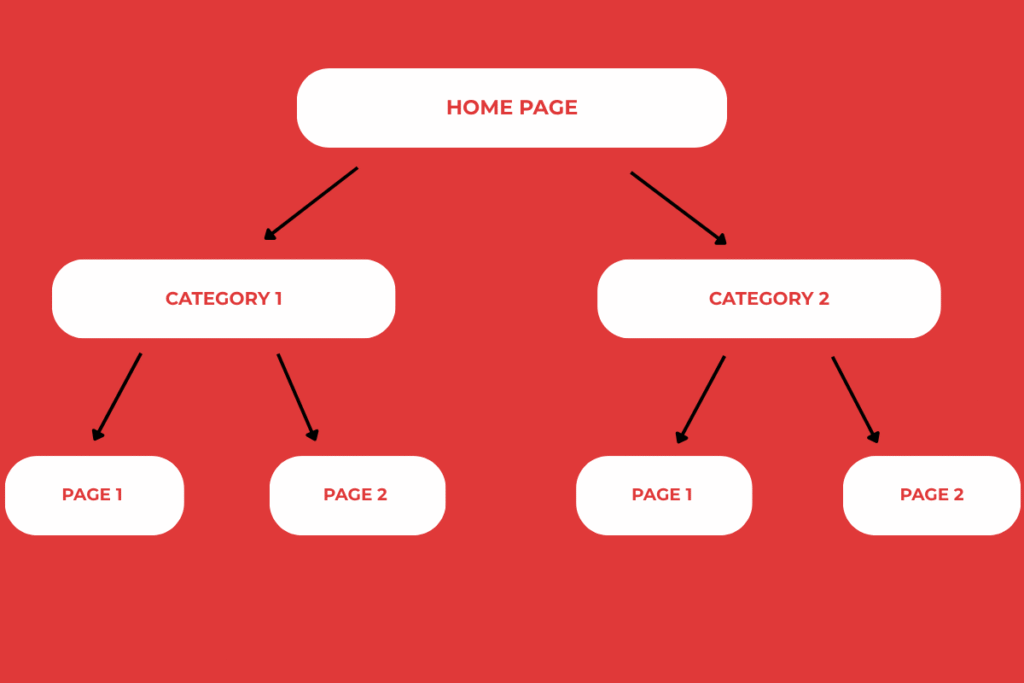
Internal linking structure strategies revolve around architecting a logical and navigable web of connections between various pages on your own website. This thoughtful interlinking benefits both your site’s visitors and the meticulous algorithms of search engines, aiding in content discovery and navigation.
Distributing Link Equity: Internal links serve to strategically distribute “link equity” (often referred to as “link juice”) from pages with higher authority to those that might need a boost, thereby enhancing their overall perceived authority.
Enhancing User Experience: Thoughtfully placed internal links gently guide users to related and complementary content, encouraging them to spend more time exploring your site and simultaneously reducing bounce rates.
Employing Descriptive Anchor Text: The clickable text of your internal link (known as anchor text) should always be highly descriptive and directly relevant to the content of the linked page. For instance, rather than a generic “click here,” opt for a more informative phrase like “explore advanced on-page SEO techniques.”
Strategic Keyword Placement: Your Target Keyword Integration Blueprint
This crucial phase is where your diligent keyword research truly blossoms into tangible results. Target keyword placement strategy is about embedding your primary, secondary, and long tail keywords organically throughout your content, consciously avoiding any semblance of forced or unnatural keyword stuffing.
In the Prominent H1 and Opening Paragraph: Aim to introduce your primary keyword (“on page seo”) within your main H1 heading and then naturally within the initial 100-150 words of your body content. This immediate presence serves as a strong signal to search engines regarding your page’s central topic.
Throughout Subheadings: As discussed, make intelligent use of your main keyword and its variations in your H2 and H3 headings.
In the Body Text: Integrate your chosen keywords seamlessly wherever they naturally fit into the narrative flow. Broaden your scope to include related terms (your LSI keywords) and various long-tail permutations. For instance, if your primary focus is “on page seo,” you might organically include phrases like “on-site optimization,” “website SEO best practices,” or “essential search engine optimization factors.”
In the Concluding Remarks: Thoughtfully reiterate your main keyword and the article’s key takeaways in your concluding section, providing a strong sense of closure.
Readability Reigns Supreme: Never, under any circumstances, compromise the readability of your content for the sake of keyword density. Google’s sophisticated algorithms are adept at understanding context, synonyms, and natural language. Prioritize writing for your human audience first, and then integrate keywords discreetly and naturally. conduct comprehensive keyword research using our guide on keyword research best practices.
Sustaining Visitor Interest: Strategies to Enhance Dwell Time Signals
Dwell time – the duration a user spends actively engaged with your page after navigating from the SERPs – stands as a pivotal user signal. Extended dwell times strongly indicate that your content is highly relevant, genuinely valuable, and deeply engaging. Comprehending how to enhance dwell time signals is therefore paramount to your SEO success.
Exceptional, Engaging Content: This is the non-negotiable foundation. Your content must be meticulously written, profoundly informative, and genuinely address the user’s initial query or need.
Optimized Readability: Employ succinct paragraphs, compelling bullet points, clear numbered lists, and distinct headings. Actively break up dense blocks of text to improve visual flow.
Strategic Visuals: Integrate pertinent images, compelling videos, insightful infographics, and relevant charts to make your content more visually appealing, digestible, and engaging.
Interactive Elements: Explore incorporating interactive components such as quizzes, polls, or active comment sections to foster greater user participation.
Intelligent Internal Linking: Guide users seamlessly to other valuable and related content within your site, further enriching their experience and naturally extending their dwell time.
Clear Digital Paths: URL Optimization Best Practices
Your URL functions as another crucial signaling mechanism for both search engines and your site’s visitors regarding the content of your page. Adhering to URL optimization best practices involves creating URLs that are clean, intuitively descriptive, and appropriately keyword-rich.
Concise and Direct: Strive to keep your URLs brief, to the point, and free from unnecessary verbosity.
Keyword Inclusion: Strategically incorporate your primary keyword (e.g., “on-page-seo” for this blog post) directly within the URL itself.
Hyphen Usage: Always separate words within your URL using hyphens (-) rather than underscores (_), as hyphens are generally preferred by search engines.
Eliminate Superfluous Characters: Avoid including arbitrary numbers, unnecessary dates (unless the content is strictly time-sensitive and will not be updated), or random strings of characters.
Illustrative Example: A URL like yourwebsite.com/guide-on-page-seo-factors is demonstrably superior to a less optimized version such as yourwebsite.com/blog/post-id-12345?cat=seo.
Delving Deeper: The Distinct Types of On-Page SEO You Must Master
Beyond the overarching techniques discussed, it’s highly beneficial to grasp the various types of on-page SEO you must know to execute a truly exhaustive and effective optimization strategy. This isn’t merely a singular checklist; it embodies a sophisticated, multi-faceted approach.
While we’ve touched upon numerous aspects, let’s briefly categorize them to provide a clearer framework:
Content-Centric SEO:
This category encompasses the inherent quality, direct relevance, and organized structure of your written content. It includes meticulous keyword integration, ensuring optimal readability, and consistently meeting the explicit and implicit user intent. This forms the very heart of on page in SEO.
Technical On-Page SEO:
This involves critical elements such as your site’s URL structure, the implementation of schema markup (structured data), rigorous page speed optimization, and ensuring complete mobile-friendliness. These factors directly influence how efficiently search engines can crawl, understand, and index your website. optimize URLs and schema markup—learn more in our technical SEO guide.
User Experience (UX) Driven On-Page SEO:
This facet concentrates on elements that profoundly enhance how users interact with your web page. Examples include intuitive navigation, compelling and relevant visuals, and content designed to naturally encourage longer dwell times. These positive user signals, in turn, indirectly yet significantly influence your search rankings.
A clear understanding of these distinct, yet intricately interconnected, on-page SEO factors enables the development of a more strategic, nuanced, and ultimately holistic approach to your website’s optimization.
The Blueprint of a Top-Ranking Page: A Comprehensive Explanation of On-Page SEO Elements
To genuinely attain and sustain high rankings, it’s imperative to conceptualize how all the complete on-page SEO elements explained thus far function in perfect synergy. The objective isn’t to optimize each factor in isolation, but rather to skillfully interweave them into a seamlessly cohesive and powerful strategy.
Imagine a hypothetical, highly ranked page:
- A compelling H1 immediately and unequivocally communicates the page’s core subject to both human visitors and Google’s algorithms.
- A concise, keyword-rich URL acts as a clear textual reinforcement of that core message.
- An engaging meta title and description serve as an irresistible invitation, drawing users directly from the search engine results pages.
- Content that is meticulously structured with appropriate H2s and H3s ensures effortless readability and allows for quick scanning.
- Keywords are integrated with absolute naturalness, encompassing not only primary terms but also pertinent LSI keywords and precise long tail keywords like “how to effectively improve on-page SEO.”
- Optimized images, complete with descriptive alt text, enhance visual appeal, improve accessibility, and provide additional contextual signals.
- Strategic internal links skillfully guide users to related content, deepening their engagement and naturally extending their time on site.
- The page loads with impressive speed and flawlessly adapts to various screen sizes, ensuring it is mobile-friendly.
- Potentially, it may even leverage schema markup to generate rich snippets in search results, making the listing exceptionally prominent.
This integrated, holistic methodology, where every single on-page element is meticulously designed and expertly implemented, is precisely what distinguishes a merely existing web page from one that consistently achieves top-tier rankings.
Future-Proofing Your Rankings: Cutting-Edge On-Site SEO Optimization Techniques for 2025
The landscape of SEO is in a perpetual state of flux, yet the fundamental principles governing effective on-site SEO optimization remain steadfast and enduring. As we project forward to 2025, several emerging trends powerfully underscore the persistent and even growing importance of on-page endeavors:
The Dawn of AI-Powered Search & Generative AI:
With the ascendance of AI Overviews and other generative AI functionalities within search results, the imperative for truly comprehensive, exceptionally high-quality content that thoroughly addresses user intent is profoundly magnified. AI models, trained on colossal datasets, will synthesize information. If your page is recognized as the definitive, authoritative resource on a topic, it significantly increases its likelihood of being cited or expertly summarized. This necessitates a strategic pivot towards topic clusters over individual keywords, covering subjects exhaustively to demonstrate profound expertise.
Reinforced E-E-A-T (Experience, Expertise, Authoritativeness, Trustworthiness):
Google continues to place intensified emphasis on E-E-A-T signals. On-page, this translates to rigorously ensuring your content is factually impeccable, thoroughly researched, and ideally, authored by or clearly attributed to recognized experts in the field. Displaying transparent author bios, citing credible sources, and providing clear contact information can substantially foster trust.
User Experience (UX) as an Intrinsic Ranking Factor:
Page experience signals, most notably Core Web Vitals (Largest Contentful Paint, First Input Delay, Cumulative Layout Shift), remain critically important. A website that loads swiftly, performs stably, and offers a visually pleasing experience directly contributes to a positive user interaction, which Google explicitly and generously rewards. This emphatically reiterates the ongoing significance of mobile-friendliness and rapid page speed.
The Evolution of Semantic SEO:
Moving beyond mere exact keyword matching, search engines are increasingly sophisticated in their capacity to comprehend the intricate relationships between distinct concepts. This means the natural integration of Latent Semantic Indexing (LSI) keywords and related terminology helps Google build a richer, deeper understanding of the breadth and depth of your content. This is precisely where your carefully chosen LSI keywords will truly demonstrate their power.
The Rise of Visual Search and Video Content:
Optimizing images and video content with descriptive file names, accurate alt text, and structured data will become even more crucial as visual search capabilities advance and video content solidifies its dominant position in online consumption.
The best on-site SEO optimization techniques 2025 will continue to revolve around the core principle of crafting exceptional user experiences by publishing high-quality, relevant, and exhaustively comprehensive content that is technically robust and effortlessly understandable by search engines.
Your Strategic Blueprint: A Step-by-Step On-Page SEO Activities Guide
Are you ready to translate these powerful principles into tangible action? Here’s a pragmatic, step-by-step on-page SEO activities guide designed to propel you forward:
Foundational Keyword Research:
Before even beginning to write, conduct exhaustive keyword research. Identify your primary keyword (“on page seo”), pinpoint relevant secondary keywords, discover compelling LSI keywords, and uncover valuable long tail keywords directly related to your chosen topic. Critically, understand the underlying search intent behind each of these keywords.
Strategic Content Planning and Outline Creation:
Based on your comprehensive keyword research, meticulously construct a detailed content outline, clearly defining your H1, H2, and H3 headings. Ensure your outline is designed to cover the topic in a thorough and logically organized manner.
Crafting Compelling and Original Content:
Write high-quality, genuinely engaging, and completely unique content that precisely addresses the user’s intent. Naturally integrate your researched keywords throughout the text, giving particular attention to the H1 heading and the opening paragraph. Strive for significant depth and provide undeniable value.
Meticulous HTML Tag Optimization:
H1: Confirm that your primary keyword is seamlessly embedded within your single H1 tag.
H2/H3: Leverage relevant secondary and long tail keywords within your subheadings to enhance topical relevance.
Meta Title: Compose an attractive, keyword-rich title (ideally under 60 characters to prevent truncation) specifically for display in the search engine results.
Meta Description: Develop a captivating and concise summary (approximately 150-160 characters) that includes relevant keywords to entice clicks.
Thorough Image Optimization:
Implement image compression techniques to ensure rapid page loading times.
Write genuinely descriptive alt text for each image, incorporating keywords naturally when contextually appropriate.
Assign descriptive, keyword-friendly file names to all your images.
Strategic URL Optimization:
Create URLs that are short, highly descriptive, and intelligently incorporate your target keywords.
Effective Internal Linking:
Establish robust internal links connecting to other relevant pages within your own website, utilizing descriptive and contextual anchor text.
Prioritize Readability and User Experience (UX):
Break up extensive text blocks, utilize bullet points and numbered lists, employ concise sentences, and integrate compelling visuals. Crucially, ensure your website is fully mobile-friendly and loads with impressive speed.
Advanced Schema Markup (Optional but Recommended):
Explore the implementation of schema markup for relevant content types (e.g., articles, FAQs, how-to guides) to potentially generate richer, more prominent snippets in search results.
Consistent Review and Updating:
On-page SEO is not a one-off task. Regularly review your content for factual accuracy, freshness, and identify ongoing opportunities for updates or further optimization.
By diligently following this comprehensive guide, you will be exceptionally well-equipped to master on-page SEO and achieve significantly higher, more sustainable rankings for your digital properties.
Conclusion: Mastering On-Page SEO for Sustainable Growth
In SEO, on-page SEO is a paramount pillar for sustainable growth. It’s about meticulously crafting every web page to be valuable, understandable, and accessible to both algorithms and your audience. By focusing on core on-page SEO factors—like structured content, optimized HTML, smart keyword placement (including LSI keywords and long tail keywords), and excellent UX—you build a robust digital asset. As search emphasizes quality and context, mastering on-page SEO ensures your content consistently stands out, attracting relevant traffic and contributing to your long-term online success.
